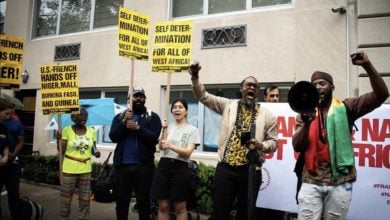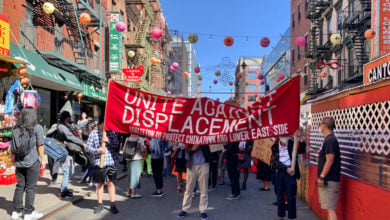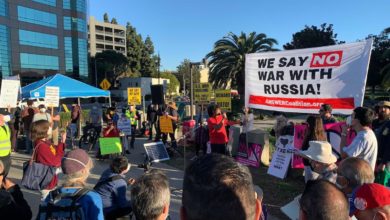
As tens of thousands prepare to demonstrate at the Pentagon against the war in Iraq, today’s anti-war movement can benefit from many lessons of the movement against the Vietnam War—especially since this year’s march comes 40 years after the historic 1967 March on the Pentagon.
The Oct. 21, 1967 demonstration at the Pentagon was significant because of the domestic and global circumstances that set the stage for the mass turnout. It signaled the beginning of a change in the orientation of a substantial sector of the anti-war movement from a predominantly pacifist “loyal opposition” to militant defiance and opposition to U.S. imperialism’s efforts to dominate Southeast Asia. A smaller but powerful wing of the movement came out in support of Vietnam’s communist-led liberation movement, the National Liberation Front.
Direct U.S. military involvement in Vietnam began immediately after the French imperialist’s decisive military defeat at Dien Bien Phu in 1954 at the hands of the Vietnamese freedom fighters. As the new predominant power in Southeast Asia, the U.S. government had sent about 1,000 military “advisers” to prop up the South Vietnamese puppet regime.
By 1963, when John Kennedy was assassinated, the number of U.S. military personnel had reached 15,000. The new Democratic administration of Lyndon B. Johnson, responding to the growing strength the Vietnamese resistance, dropped the fiction of “advisers” and committed 100,000 U.S. troops to Vietnam in 1965. By 1966, U.S. troops in Vietnam numbered over 300,000.
Like today’s war in Iraq, the U.S. government justified the massive troop escalation with a lie. In Vietnam it was the August 1964 Gulf of Tonkin incident, when North Vietnamese gunboats supposedly fired on two U.S. destroyers in the waters off Vietnam’s coast. In the ensuing hysteria, Congress authorized Johnson to use “all necessary steps” to protect U.S. interests in Southeast Asia.
The only problem was that the Vietnamese attack never happened—a fact that is now widely acknowledged. The entire incident was fabricated by the Pentagon to create the political conditions for escalating the war.
In fact, during Johnson’s 1964 election campaign, he had promised not to send regular troops. But the growing Vietnamese resistance was making clear that U.S. dominance of the region was in danger. By 1967, no amount of U.S. government propaganda could hide the fact that the Vietnamese people were fighting the greatest military power on Earth to a standstill.
Combined with the growing Vietnamese liberation movement, U.S. imperialism was being challenged across much of the oppressed and formerly colonized world. The 1959 Cuban Revolution was a beacon of struggle throughout Latin America, and liberation struggles were gaining strength and winning across Africa.
The war at home
A decisive factor in the 1967 Pentagon demonstration was the widening people’s struggle within the United States itself. At the heart of that struggle was the civil rights movement, where the African American masses were pushing forward against racist violence and discrimination.
This movement, in turn, had a tremendous impact on other oppressed sectors of the population—Latinos, Native Americans and others. These communities, already mobilizing and organizing to win basic democratic and social rights at home, opposed the war based on their own reasoning and interests. The Pentagon relied on disproportionate drafting from poor and nationally oppressed communities to make up for the rising body count.
Rebellions in Newark and Plainfield, New Jersey in July 1967 against racism and police brutality—echoing the Watts uprising in Los Angeles in 1965—became a key factor in weakening and discrediting the U.S. ruling class in the eyes of working people in the United States and around the world. Combined with the heroic efforts of the Vietnamese liberation forces, the Pentagon was on the defensive.
On April 4, 1967, Martin Luther King, Jr. made his famous speech, “Beyond Vietnam: Time to break silence,” at New York City’s Riverside Church. He condemned the U.S. war in Vietnam as an injustice that was connected to racist oppression in this country.
This view was not only King’s personal opinion. It was a reflection of an evolving merging of the anti-war and the civil rights and Black liberation movements into a general struggle against the racist war-making class. But King’s statement had a profound effect that gave moral and political strength to the two movements.
The linkage was being felt in all areas of U.S. society. On June 25, 1967, heavyweight-boxing champion Muhammad Ali was stripped of his title and arrested for refusing induction into the military after he was denied conscientious objector status. “I ain’t got no quarrel with the Viet Cong,” he said.
The Black Panther Party, which had started in reaction to police brutality, increasingly portrayed the fight against the war as part of the struggle for revolution in the United States.
Top military and government officials became concerned with the politically alarming situation.
A day of militant protest
By the time of the demonstration at the Pentagon on Oct. 21, 1967, the level of militancy across the country had reached new heights. Over 50,000 people gathered at the Lincoln Memorial by the middle of the day. A wide number of groups mobilized, ranging from the theatrical efforts of Abbie Hoffman to “levitate the Pentagon” to the group I came with, the Puerto Rican Pro-Independence Movement. One of the most significant and militant contingents at this demonstration was the Vietnam Veterans Against the War.
More than usual, young activists carried the flag of the Vietnamese National Liberation Front. Chants like, “Ho, Ho, Ho Chi Minh! The NLF is going to win!” which would later be embraced by thousands, began to be heard. Ho Chi Minh was the leader of the Vietnamese revolution.
After the rally ended, the demonstrators marched through Washington, D.C. to the Pentagon. When the demonstration arrived at the Pentagon, they were met by at least 2,500 U.S. Army troops and 200 U.S. marshals in a human barricade surrounding the huge building.
These soldiers were armed with bayoneted M-14 rifles and tear gas canisters. Student activists tried to appeal to the soldiers, putting flowers into the barrels of the soldiers’ rifles.
Confrontations broke out when people attempted to cross the restricted line of defense surrounding the Pentagon. Throughout the day, soldiers were ordered to shoot tear gas into the crowd in order to repel their aggressive moves towards the heavily fortified structure.
At one point, a group of several hundred young protesters stormed through, passing the tear gas and swinging clubs of the military-police line of defense. These anti-war demonstrators battled with the armed troops, managing to penetrate into the ground level floor of the Pentagon. Many of these demonstrators managed to go up the staircase towards upper floors where the battle continued as they endured blows from nightsticks and rifle butts as well as tear gas.
By the time the weekend of protest ended, 681 people had been arrested. Although the war continued for several more years, the confrontation that resulted at the Pentagon revealed to the world through television a new kind of resentment that existed towards the U.S. war machine within the United States itself. The rulers and military strategists became increasingly defensive in how they promoted their presence in Vietnam.
Although the world has changed since, developing a militant anti-war movement in solidarity with oppressed peoples both targeted by the Pentagon and within the United States itself, galvanizing all sectors of the population, can have far-reaching benefits—at the same time weakening the position of the warmongering U.S. rulers.
100 5 minutes read






